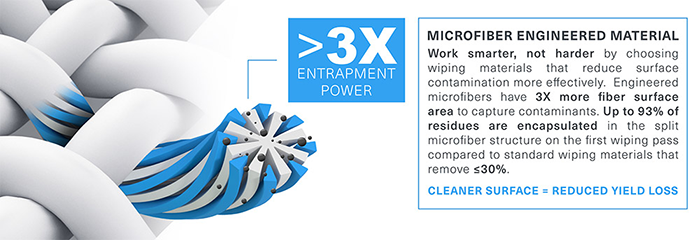
Polyester knit materials, known well for their exceptional cleanliness, have long been the “queen of the cleanroom.” With their long, continuous filament structure, polyester materials are very low-shedding, which is critically important for cleanrooms requiring a pristine-as-can-be environment.
Nonwoven materials, such as polyester cellulose, and polypropylenes are a very economical choice. However, their hydroentangled, thermally fused, or chemically bonded structures can result in a higher amount of shedding or leave residuals behind after cleaning.
While these materials are commonly used, each have significant performance drawbacks. Polyester knit materials tend to smear oily residues and leave hazy finishes, and work poorly to either apply or absorb fluids. Nonwoven materials often leave fiber contamination behind and do not work well on surfaces that are uneven. Durability in-use is often an issue.
Woven microfiber materials have been gaining popularity within cleanroom environments for many reasons:
- Woven microfiber wipes have demonstrated superior microcontamination removal compared to polyester and nonwoven materials. Various studies and comparative wiping tests have shown microfiber to be very effective in removing leftover residuals.
- Its continuous filament strength of polyester make it an excellent choice for cleaning rough and uneven surfaces.
- The nylon component of microfiber lends the material flexibility and conformity, which is terrific for cleaning tight corners, crevices, and other hard to clean areas and edges.
- Compared to more premium-priced polyester, microfiber has better absorbency and is a more cost-effective wiping solution.
- The fabric’s softness makes microfiber an optimal choice for cleaning highly sensitive surfaces such as optics and lenses.
To demonstrate microfiber’s effectiveness in removing dry particle and oily micro-contamination, we conducted a quick test using an industry-leading polyester knit wiper and microfiber knit wiper, under a black light, to reveal what is not easily observed under normal light.
In both cases, the polyester knit wiper (on the left) is simply not as effective as microfiber (on the right) in removing residual contamination.
Removing Dry Particulates
This content is hosted by a third party (youtube.com). To view external content you must agree to cookies.
Removing Oily Residues
This content is hosted by a third party (youtube.com). To view external content you must agree to cookies.
Microfiber Use Applications for Various Industries
Microfiber offers a more cost-effective solution for a wide range of applications across many industries. We detail some of the best uses for microfiber in the life sciences, pharmaceutical, medical device, and semiconductor segments:
Microfiber for Pharmaceutical & Life Science Applications
- Suitable for use in tableting and injectables operations, biological safety cabinets, and QA/QC Labs
- Superior single-pass micro-contamination removal
- Light-weight and durable for effectively wiping irregular surfaces and crevices
- Knit microfiber is highly durable, ideal for large area micro-contamination removal and spill control
Microfiber for Medical Device & Biotech Applications
- Best for micro-electronic device manufacturing, critical component assembly, and metal machining, coating & 3-D printing
- Removing baked-on process by-products and contaminants
- Working with strong cleaning solvents
- High tear/shed resistance for rough, abrasive surfaces
- Cleaning sensors and optics
- Cleaning a complex range of material surfaces such as epoxy & silicone
- Final wipe down of guide wires and catheters
Microfiber for Semiconductor Applications
- Suitable for use in lab and tool maintenance areas
- Enhanced scrubbing performance, especially inside tools
- Resists shedding on textured surfaces and rough equipment edges
- Highly effective in entrapping foreign materials and residues
We invite you to look at Teknipure’s range of microfiber wiping solution online at ThomasSci.com